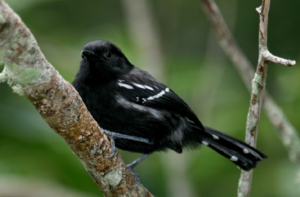Resting goat ant catcher
| Resting goat ant catcher | ||||||||||||
|---|---|---|---|---|---|---|---|---|---|---|---|---|

Resting goat ant catcher ( Formicivora littoralis ) |
||||||||||||
| Systematics | ||||||||||||
|
||||||||||||
| Scientific name | ||||||||||||
| Formicivora littoralis | ||||||||||||
| Gonzaga & Pacheco , 1990 |
The remaining gaunt catcher ( Formicivora littoralis ) is a rare species of bird in the ant bird family . The taxon was described in 1990 as a subspecies of the mountain ant catcher ( Formicivora serrana ) and has been an independent species since 1992.
description
The remaining gauntlet reaches a length of 12.5 centimeters. The head, neck and underside of the male are black. The shoulders are characterized by two or three narrow white wing bands. The back is dark gray-black. The white flank feathers are usually hidden. The tail is black with small, white apical spots. The female has a rust-brown top, a darker skull and a wide black face mask. The eyebrows are whitish. The wings are dark. The underside is beige-cream colored. The tail color is similar to that of the male. The singing consists of rapid series of deep thiúk tones. The call is a high-pitched nasal kiu-kiu-kiu .
distribution and habitat
The remaining goat ant catcher is endemic in the Cabo Frio coastal region near Arraial do Cabo and on the Ilha do Cabo Frio in the Brazilian state of Rio de Janeiro, east of the city of Rio de Janeiro . Its habitat is the Restinga , a dune landscape that is dominated by bushes, cacti and bromeliads .
Way of life
The remaining gaunt catcher usually goes for food in pairs and feeds mainly on ants. He stays close to the ground in the thick undergrowth. Nests were discovered on the Ilha do Cabo Frio in June, October and November. However, the breeding season is not limited to a particular season. The nest is made of fibers and horizontally installed branch forks. The clutch consists of two eggs and both parents take care of raising the young.
status
The remaining goat ant catcher occurs in a restricted habitat with an area of 205 km², which is endangered by the construction of holiday homes and the salt industry. BirdLife International estimates the population at 250 to 1000 individuals. Protected areas are located at Jacarepiá, Maçambaba and on the Ilha do Cabo Frio.
literature
- J. Del Hoyo, A. Elliot, D. Christie (Eds.): Handbook of the Birds of the World. Volume 8: Broadbills to Tapaculos. Lynx Edicions, 2003, ISBN 84-87334-50-4 .
- Erik Hirschfeld: The Rare Birds Yearbook 2008. MagDig Media, Shrewsbury 2007, ISBN 978-0-9552607-3-5
Web links
- Formicivora littoralis in the endangered Red List species the IUCN 2008. Posted by: BirdLife International, 2008. Accessed January 31 of 2009.
- BirdLife factsheet
- ONG de Iguaba Grande participa de projeto internacional Article about the Restinga ant catcher with photo (Portuguese)
- Restinga de Maçambaba / Cabo Frio, Rio de Janeiro Article about the Restinga with a photo of the Restinga ant catcher (Portuguese)